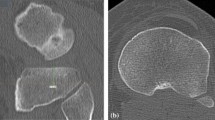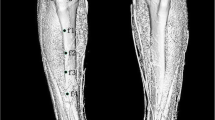Abstract
Purpose
The main purpose of this study was to identify how the accuracy of the tibial rotation reference axes varied in populations with different tibial tubercle locations. We hypothesized that the accuracy of the axes of tibial rotation would be affected by the changes of tibial tubercle locations.
Methods
Surgical epicondylar axis (SEA), medial third of the patellar tendon (1/3MPT), medial third of the tibial tuberosity (1/3MTT), medial border of the tibial tuberosity (MTT) and Akagi line were drawn. The angle between SEA and horizontal line with the angle between the four tibial rotation axes and the horizontal line was compared by T test. Then, the correlation between TTTG with the angles between the four axes and SEA vertical lines was analyzed. The TTTG was divided into three subgroups (TTTG < 10 mm, 10 mm ≤ TTTG < 15 mm, TTTG ≥ 15 mm), then t test was performed for the angles between the vertical lines of the SEA and the four rotation axes of the tibia in each group.
Results
Among the four tibial rotation axes, only the difference between MTT and the line perpendicular to SEA had no statistical significance (NS.). The four tibial rotational axes were all positively correlated with TTTG (p < 0.001). When TTTG ≥ 15 mm, Akagi line was 2.5° ± 6.9°internally rotated to the line perpendicular to SEA, while the 1/3MPT and MTT was 0.9° ± 5.3°and 1.3° ± 5.9°externally rotated to the line perpendicular to the SEA when TTTG < 10 mm and 10 mm ≤ TTTG < 15 mm, respectively.
Conclusions
MTT showed the best consistency with SEA. TT-TG had a significant positive correlation with all four tibial rotational axes. In patients with TTTG < 10 mm, 10 mm ≤ TTTG < 15 mm and TTTG ≥ 15 mm, the 1/3MPT, MTT and Akagi line demonstrated good alignment consistency with SEA, respectively.

Similar content being viewed by others
References
Akagi M, Mori S, Nishimura S, Nishimura A, Asano T, Hamanishi C (2005) Variability of extraarticular tibial rotation references for total knee arthroplasty. Clin Orthop Relat Res. https://doi.org/10.1097/01.blo.0000160027.52481.32172-176
Akagi M, Oh M, Nonaka T, Tsujimoto H, Asano T, Hamanishi C (2004) An anteroposterior axis of the tibia for total knee arthroplasty. Clin Orthop Relat Res. https://doi.org/10.1097/00003086-200403000-00030213-219
Asano T, Akagi M, Tanaka K, Tamura J, Nakamura T (2001) In vivo three-dimensional knee kinematics using a biplanar image-matching technique. Clin Orthop Relat Res. https://doi.org/10.1097/00003086-200107000-00023157-166
Balcarek P, Jung K, Ammon J, Walde TA, Frosch S, Schuttrumpf JP et al (2010) Anatomy of lateral patellar instability: trochlear dysplasia and tibial tubercle-trochlear groove distance is more pronounced in women who dislocate the patella. Am J Sports Med 38:2320–2327
Baldini A, Indelli PF, Del L, Mariani PC, Marcucci M (2013) Rotational alignment of the tibial component in total knee arthroplasty: the anterior tibial cortex is a reliable landmark. Joints 1:155–160
Bedard M, Vince KG, Redfern J, Collen SR (2011) Internal rotation of the tibial component is frequent in stiff total knee arthroplasty. Clin Orthop Relat Res 469:2346–2355
Bell SW, Young P, Drury C, Smith J, Anthony I, Jones B et al (2014) Component rotational alignment in unexplained painful primary total knee arthroplasty. Knee 21:272–277
Dalury DF (2001) Observations of the proximal tibia in total knee arthroplasty. Clin Orthop Relat Res. https://doi.org/10.1097/00003086-200108000-00021150-155
Drexler M, Backstein D, Studler U, Lakstein D, Haviv B, Schwarzkopf R et al (2017) The medial border of the tibial tuberosity as an auxiliary tool for tibial component rotational alignment during total knee arthroplasty (TKA). Knee Surg Sports Traumatol Arthrosc 25:1736–1742
Eisenhuth SA, Saleh KJ, Cui Q, Clark CR, Brown TE (2006) Patellofemoral instability after total knee arthroplasty. Clin Orthop Relat Res 446:149–160
Fottner A, Woiczinski M, Schroder C, Schmidutz F, Weber P, Muller PE et al (2020) Impact of tibial baseplate malposition on kinematics, contact forces and ligament tensions in TKA A numerical analysis. J Mech Behav Biomed Mater 103:103564
Graw BP, Harris AH, Tripuraneni KR, Giori NJ (2010) Rotational references for total knee arthroplasty tibial components change with level of resection. Clin Orthop Relat Res 468:2734–2738
Hofmann S, Romero J, Roth-Schiffl E, Albrecht T (2003) Rotational malalignment of the components may cause chronic pain or early failure in total knee arthroplasty. Orthopade 32:469–476
Howell SM, Chen J, Hull ML (2013) Variability of the location of the tibial tubercle affects the rotational alignment of the tibial component in kinematically aligned total knee arthroplasty. Knee Surg Sports Traumatol Arthrosc 21:2288–2295
Incavo SJ, Wild JJ, Coughlin KM, Beynnon BD (2007) Early revision for component malrotation in total knee arthroplasty. Clin Orthop Relat Res 458:131–136
Kuriyama S, Ishikawa M, Furu M, Ito H, Matsuda S (2014) Malrotated tibial component increases medial collateral ligament tension in total knee arthroplasty. J Orthop Res 32:1658–1666
Lakstein D, Zarrabian M, Kosashvili Y, Safir O, Gross AE, Backstein D (2010) Revision total knee arthroplasty for component malrotation is highly beneficial: a case control study. J Arthroplasty 25:1047–1052
Lu Y, Ren X, Liu B, Xu P, Hao Y (2020) Tibiofemoral rotation alignment in the normal knee joints among Chinese adults: a CT analysis. BMC Musculoskelet Disord 21:323
Nicoll D, Rowley DI (2010) Internal rotational error of the tibial component is a major cause of pain after total knee replacement. J Bone Joint Surg Br 92:1238–1244
Osano K, Nagamine R, Todo M, Kawasaki M (2014) The effect of malrotation of tibial component of total knee arthroplasty on tibial insert during high flexion using a finite element analysis. Scient World J 2014:695028
Panni AS, Ascione F, Rossini M, Braile A, Corona K, Vasso M et al (2018) Tibial internal rotation negatively affects clinical outcomes in total knee arthroplasty: a systematic review. Knee Surg Sports Traumatol Arthrosc 26:1636–1644
Pennock AT, Alam M, Bastrom T (2014) Variation in tibial tubercle-trochlear groove measurement as a function of age, sex, size, and patellar instability. Am J Sports Med 42:389–393
Planckaert C, Larose G, Ranger P, Lacelle M, Fuentes A, Hagemeister N (2018) Total knee arthroplasty with unexplained pain: new insights from kinematics. Arch Orthop Trauma Surg 138:553–561
Saffarini M, Nover L, Tandogan R, Becker R, Moser LB, Hirschmann MT et al (2019) The original Akagi line is the most reliable: a systematic review of landmarks for rotational alignment of the tibial component in TKA. Knee Surg Sports Traumatol Arthrosc 27:1018–1027
Schoettle PB, Zanetti M, Seifert B, Pfirrmann CW, Fucentese SF, Romero J (2006) The tibial tuberosity-trochlear groove distance; a comparative study between CT and MRI scanning. Knee 13:26–31
Siston RA, Giori NJ, Goodman SB, Delp SL (2006) Intraoperative passive kinematics of osteoarthritic knees before and after total knee arthroplasty. J Orthop Res 24:1607–1614
Siston RA, Goodman SB, Patel JJ, Delp SL, Giori NJ (2006) The high variability of tibial rotational alignment in total knee arthroplasty. Clin Orthop Relat Res 452:65–69
Stephen JM, Dodds AL, Lumpaopong P, Kader D, Williams A, Amis AA (2015) The ability of medial patellofemoral ligament reconstruction to correct patellar kinematics and contact mechanics in the presence of a lateralized tibial tubercle. Am J Sports Med 43:2198–2207
Tanaka MJ, Elias JJ, Williams AA, Carrino JA, Cosgarea AJ (2015) Correlation between changes in tibial tuberosity-trochlear groove distance and patellar position during active knee extension on dynamic kinematic computed tomographic imaging. Arthroscopy 31:1748–1755
Tao K, Cai M, Zhu Y, Lou L, Cai Z (2014) Aligning the tibial component with medial border of the tibial tubercle–is it always right? Knee 21:295–298
Uehara K, Kadoya Y, Kobayashi A, Ohashi H, Yamano Y (2002) Bone anatomy and rotational alignment in total knee arthroplasty. Clin Orthop Relat Res. https://doi.org/10.1097/00003086-200209000-00018196-201
Bos J, van der Heide HJ, Nelissen RG (2011) A computed tomography based study on rotational alignment accuracy of the femoral component in total knee arthroplasty using computer-assisted orthopaedic surgery. Int Orthop 35:845–850
Acknowledgements
None.
Funding
This study was funded by the National Natural Science Foundation of China (82002285).
Author information
Authors and Affiliations
Corresponding author
Ethics declarations
Conflict of interest
All the authors declare no conflict of interest.
Ethical approval
The study protocol was approved by the hospital’s Ethics Committee. The file number of the ethical approval is 2020-P2-041-01.
Additional information
Publisher's Note
Springer Nature remains neutral with regard to jurisdictional claims in published maps and institutional affiliations.
Rights and permissions
About this article
Cite this article
Yike, D., Tianjun, M., Heyong, Y. et al. Different rotational alignment of tibial component should be selected for varied tibial tubercle locations in total knee arthroplasty. Knee Surg Sports Traumatol Arthrosc 30, 3061–3067 (2022). https://doi.org/10.1007/s00167-021-06774-7
Received:
Accepted:
Published:
Issue Date:
DOI: https://doi.org/10.1007/s00167-021-06774-7




